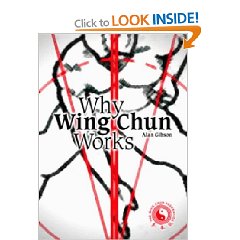While a book cannot teach you a martial art it can explain concepts that sometimes could be lost or not necessarily explained in lessons. Putting in writing certain concepts will force the author to think them through and be very specific about them: this is a typical example.

If you move across styles and train various styles of Kickboxing, Karate, Tae Kwon Do, Tang So Do and Kung fu you will realize that, more or less, kicks are kicks, punches are punches and stances are stances. More emphasis here or there but you can see a common line of evolution and many commonalities. When you talk Wing Chun you hear concepts like sensitivity, touch reflexes and central line and that can be a bit disorientating. That’s why when I found this book and read the introduction in a local book shop I bought it and read it in a short time.
The book
Why Wing Chun Works had a great influence on my martial art experience and I like to go back to it and read a few paragraphs every so often. I was so intrigued by the reading it that at the end I decided to send an Email to the author, Alan Gibson, and invite him over for a seminar that I organized. That was the beginning of a fruitful collaboration and friendship. This book was entirely written by Alan and based on his personal experience and discovery of this art of which he is a prominent representative in the UK and internationally. This was the first experience of Alan Gibson writer: he wrote and produced himself this first edition in 1998: it is spiral-bound and with hand made drawings. The book had several editions after this one and recently Alan released “Beginning Wing Chun” that is an improved version with some extra material.
Description
The basic style described here describes the Ip Chun lineage and it is based around the principles of pivoting around the central line. Wing Chun is not about learning systematically and rehearsing situations like: if this happens do this, if that happens do that and so on. It’s about absorbing, at subconscious level, subtle movements that allow to react, attack and defend in a continuous action. All “techniques” are described as “concepts”: each concept applies to various situations. The book also describes how Wing Chun principles such as straight line attack and economy or motion can be applied to problem solving and other aspect of life, not necessarily related to martial arts or to fighting.
What I like of this book
If you are a total beginner of Wing Chun or you don’t know what it is this is a great guide to discover the art and its many principles. If you are already practicing it can be a great help to understand the various concepts at a deeper level, having time to think about them while away from your usual practicing venue.
Conclusions
Why Wing Chun Works should be in every martial artist’s library: no matter whether you are a Wing Chun practitioner, a curious or simply passionate about martial arts. Don’t expect to learn Wing Chun by reading it but you can definitely improve your thinking around various techniques and, ultimately, refine them.
If you would like to buy this book, or other interesting ones, please have a look at our book store that contain a little collection of the books I read so far.

Thanks for your support Massimo!
Of course I agree with everything said here, especially the bit that says these books should be bought by everyone…